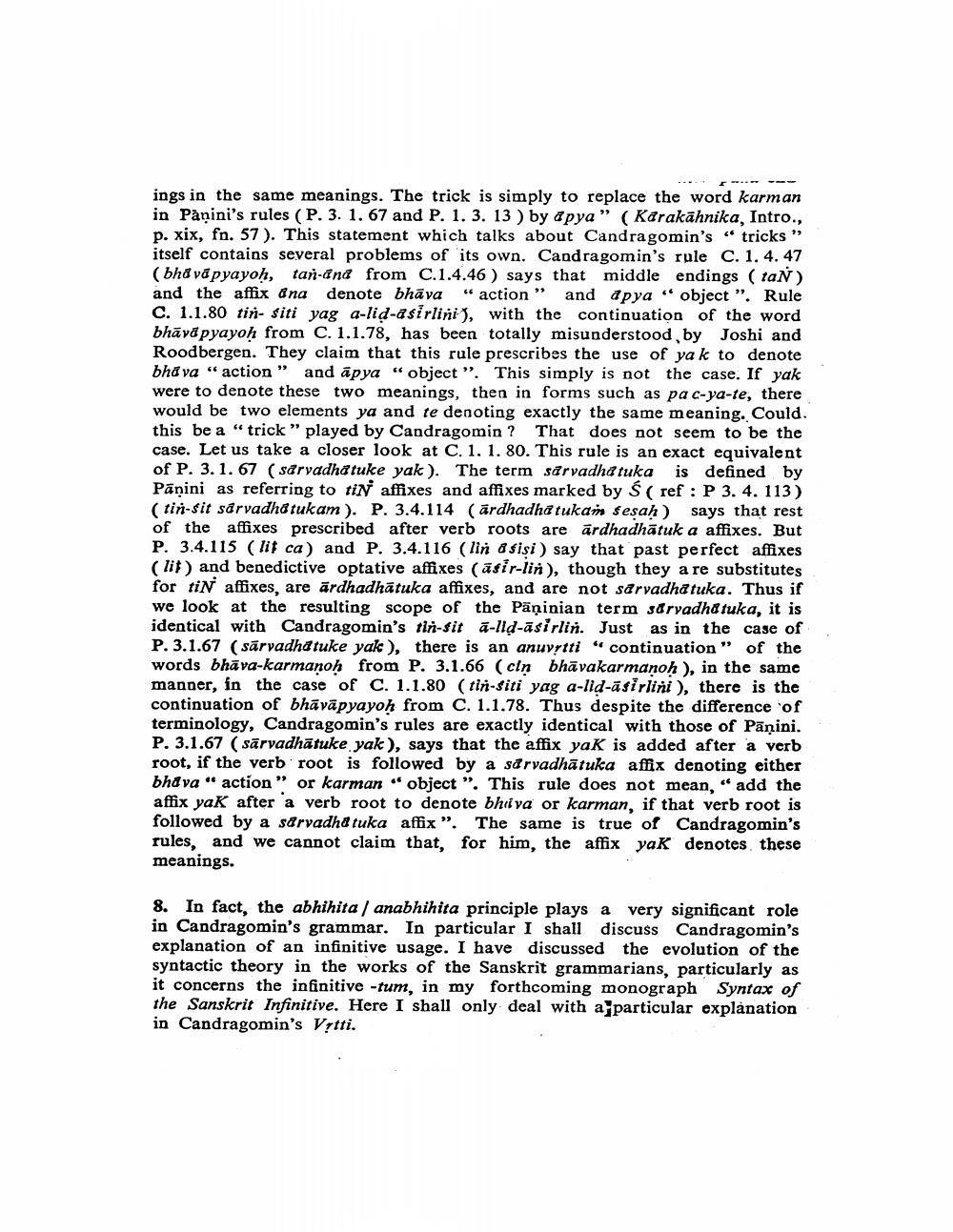Book Title: Candragomins Syntactic Rules Some Misconceptions Author(s): Mahadev Deshpande Publisher: Mahadev Deshpande View full book textPage 4
________________ ings in the same meanings. The trick is simply to replace the word karman in Panini's rules (P. 3. 1. 67 and P. 1. 3. 13 ) by a pya” (Karakāhnika, Intro., p. xix, fn. 57). This statement which talks about Candragomin's “ tricks” itself contains several problems of its own. Candragomin's rule C. 1. 4.47 (bhava pyayoh, tan-and from C.1.4.46 ) says that middle endings (tan) and the affix ina denote bhāva "action” and apya "object". Rule C. 1.1.80 tin- Siti yag a-lid-asirlini), with the continuation of the word bhāvā pyayoh from C. 1.1.78, has been totally misunderstood by Joshi and Roodbergen. They claim that this rule prescribes the use of ya k to denote bhava "action" and apya “ object". This simply is not the case. If yak were to denote these two meanings, then in forms such as pa c-ya-te, there would be two elements ya and te denoting exactly the same meaning. Could. this be a “trick" played by Candragomin? That does not seem to be the case. Let us take a closer look at C. 1. 1. 80. This rule is an exact equivalent of P. 3. 1. 67 (sarvadha tuke yak). The term sarvadha tuka is defined by Panini as referring to in affixes and affixes marked by S(ref : P 3. 4. 113) (tin-sit sarvadha tukam). P. 3.4.114 (ārdhadha tukan sesah) says that rest of the affixes prescribed after verb roots are ärdhadhātuk a affixes. But P. 3.4.115 ( lit ca) and P. 3.4.116 (lin 8 fisi) say that past perfect affixes (lit) and benedictive optative affixes (asir-lin), though they are substitutes for tiN affixes, are ardhadhātuka affixes, and are not sarvadha tuka. Thus if we look at the resulting scope of the Päninian term sarvadha tuka, it is identical with Candragomin's tin-sit a-lid-āsirlin. Just as in the case of P. 3.1.67 (sārvadha tuke yak), there is an anuyrtti" continuation" of the words bhāva-karmanoh from P. 3.1.66 (cin bhāvakarmanoh ), in the same manner, in the case of c. 1.1.80 (tin-siti yag a-lid-āsirlini ), there is the continuation of bhāvāpyayoh from C. 1.1.78. Thus despite the difference of terminology, Candragomin's rules are exactly identical with those of Pāņini. P. 3.1.67 (sārvadhātuke yak), says that the affix yaK is added after a verb root, if the verb root is followed by a sarvadhātuka affix denoting either bhava " action” or karman "object". This rule does not mean, " add the affix yaK after a verb root to denote bhiiva or karman, if that verb root is followed by a sarvadha tuka affix". The same is true of Candragomin's rules, and we cannot claim that, for him, the affix yaK denotes these meanings. 8. In fact, the abhihita / anabhihita principle plays a very significant role in Candragomin's grammar. In particular I shall discuss Candragomin's explanation of an infinitive usage. I have discussed the evolution of the syntactic theory in the works of the Sanskrit grammarians, particularly as it concerns the infinitive -tum, in my forthcoming monograph Syntax of the Sanskrit Infinitive. Here I shall only deal with a particular explanation in Candragomin's Vịtti.Page Navigation
1 2 3 4 5 6 7 8 9 10 11 12 13
